Kajian
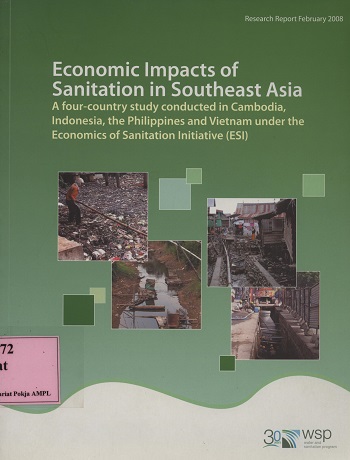
Economic Impacts of Sanitation in Southeast Asia: A four-Country study conducted in Cambodia, Indonesia, the Philippines and Vietnam under the Economic of Sanitation Initiative (ESI)
Water and Sanitation Program (WSP)
2008
2.107
Buku ini secara garis besar membahas tentang kesehatan, air, lingkungan pariwisata dan topik lainnya yang terkait dengan rendahnya sanitasi di Kamboja, Indonesia, Philipina dan Vietnam.
Sanitasi yang rendah mengakibatkan timbulnya penyakit yang berujung kematian, pencemaran sumber air, dan kerugian lainnya yang timbul akibat lingkungan yang rusak. Rendahnya sanitasi ini mempengaruhi kualitas hidup dan perekonimian masyarakat yang tinggal di sekitar lingkungan tersebut.
Semua paparan daalm buku ini berdasarkan pada penyelidikan, penelitian dan database tentang sanitasi khususnya pengelolaan tinja, pengukuran dampak sumber daya air termasuk didalamnya mengeluarkan air abu abu dari badan air dan pengukuran dampak lingkungan secara luas termasuk mengelola limbah padat.
Tujuan dibuatnya buku ini yaitu memperlihatkan kepada para pengambil keputusan baik di tingkat pusat maupun daerah tentang bagaimana dampak negatif dari rendahnya sanitasi berpengaruh terhadap investasi pembangunan sanitasi.

Economic Assessment of Sanitation Interventions in the Philipines: A Six-Country Study concucted in Cambodia, China, Indonesia, Lao PDR, the Philipines and Vietnam under the Economics of Sanitation
Water and Sanitation Program (WSP)
2011
1.624
Pembelajaran kali ini berbeda dari pembelajaran lainnya, dimana pembelajaran ini mengkaji tentang biaya dan manfaat yang terkait dengan pilihan-pilihan yang terdapat disekitar sanitasi. Manfaat yang bisa diambil meliputi dampak sanitasi terhadap kesehatan, sumber air minum dan perawatannya, dan penggunaan kembali limbah yang telah di daur ulang.
Tujuan dari pembelajaran ini yaitu untuk menyampaikan informasi kepada para pengambil kebijakan terkait dengan sanitasi, untuk memahami biaya dan manfaat memperbaiki serta membangun lokasi sanitasi di perdesaan dan perkotaan serta untuk memberikan pemahaman yang lebih baik tentang dampak sanitasi dan meningkatkan cakupan sanitasi secara nasional di Philipina .
Fakta mencerminkan akses terhadap peningkatan sanitasi merupakan kebutuhan dasar rumah tangga dan tempat kerja atau sekolah. Banyak orang yang memerlukan tempat bersih, aman, dan nyaman untuk buang air kecil dan air besar. Sanitasi juga memberikan kontribusi yang besar untuk mencapai tujuan pembangunan yaitu dengan sanitasi maka tingkat kematian anak dapat dikurangi, peningkatan status gizi, kesetaraan gender, air minum yang bersih, dan kelestarian lingkungan hidup. Untuk hal ini diperlukan kerjasama antara pemerintah, swasta, lembaga donor dan masyarakat itu sendiri.

Accompanying Volume to the Guidance Notes on Services for the Urban Poor: Global Experiences on Expanding Water and Sanitation Services to the Urban Poor
Geeta Sharma & Shikha Shukla (ed)
Th.
1.653
In 2006-2007, the Water and Sanitation Program (WSP) initiated research to identify barriers to service delivery for the urban poor. The findings of the research have been presented in the Guidance Note on Improving Water Supply and Sanitation Services to the Urban Poor in India. The Urban Global Practice Team of WSP decided to expand the ambit of this reserach to a global context as the learnings were relevant to experiences across Afica, Latin America, and East Asia and the Pacific.
The Guidance Notes are based on an in-depth research of various initiatives from across the world (including South Asian, African, Latin American, and East Asia and the Pacific countries) and consultations with urban poor communities. The present volume is a documantation of this research and supports the Guidance Notes on Services for the Urban Poor.
This volume is an extended version of a previous WSP publication, Global Experiences on Expanding Services to the Urban Poor.
Contents:
Section 1. Case Studies on Improving Water Supply and Sanitation Services for the Urban Poor
1. Parivartan: Slum Networking Project
2. The Slum Sanitation Program: Reaching the Poor through Sustainable Partnerships
3. PROSANEAR: Combining Community Participation and Low-Cost Technology
4. Federation of Water Associations: Giving the Poor a Voice
5. Orangi Pilot Project: The Poor Invest in Their Future
6. Kalyani: No Subsidy Sanitation Leads to Open-Defecation-Free Slums
7. Community-Managed Toilets: Solving Sanitation Problems of Urban Poor Communities
8. The Hyderabad Metro Water Supply and Sewerage Board: Organizational Reform for Improved Service Delivery
9. National Water and Sewerage Corporation: Utility Reform Helps the Urban Poor
10. Bangalore Water Supply and Sewerage Board: Service Delivery in Slums
11. Nongovernmental Organization-Assisted Water Points: Social Intermediation for the Urban Poor
12. Alandur Municipality: User Contributions in Infrastructure Development
13. Jamshedpur Utilities and Services Company Limited: Innovative Initiative to Provide Adequate Water
14. Temeke District: Community-Managed Water and Sanitation Program
15. Water for All: Community-Managed Water Services
16. Programs to Serve the Poor Urban Areas of Lima: Alternative Water Management Models
17. Nyalenda Water Supply Project: Delegated Management Model
18. Water Trust Model: A Community-Based Initiative
19. Social Connections and Public Standpipes: Access to Drinking Water in Disadvantaged Areas
Section 2. Consultations with Urban Poor Communities
Scope and Methodology
Overall Findings
City-Level Findings
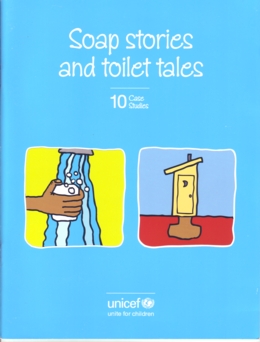
Soap Stories and Toilet Tales (10 Case Studies)
Th.
1.756
This collection of case studies highlights that existing norms, habits and attitudes can be transformed when the motivation for adopting appropriate sanitary or hygienic behavior is understood. In this process, social development outcomes emerge as central drivers for change. Privacy, dignity, affiliation and pride are important catalysts that function both as a means and an end in improving hygiene and sanitation behaviours.
The central role children play in creating hygienic schools is highlighted in the stories from Egypt, India, Senegal, and Nepal. Provision of appropriate facilities such as separate toilet blocks for girls in schools leads to higher attendance rates, especially once girls have begun menstruation and require privacy. The Bangladesh tale demonstrates how interpersonal communication can change stong taboos around menstrual hygiene, whereby girls allowed to hygienically manage their menstruation without being stigmatized.
The Bolivia, Nicaragua, Zambia, Cambodia and Sierra Leone case studies describe how collective processes of change in communities have resulted in Total Sanitation. By focusing on eliminating open-defecation, the conditions of a whole community can be transformed. Keeping a clean and healthy community can help community can help build and maintain community morale.
Contents:
Case Study 1. Egypt: Empowered for good
Case Study 2. India’s ’clean school and village’ movement
Case Study 3. Senegal ’Building for life’ – in the midst of civil insurgency
Case Study 4. Bolivia: A new-fangled device arrives in the Bolivian Altiplano: the toilet
Case Study 5. Cambodia: Village decides to bring sanitation closer to home
Case Study 6. Zambia: Chief Macha’s toilet revolution
Case Study 7. Nepals school-led total sanitation seems unstoppable
Case Study 8. Sierra Leone: Singing about the unmentionable
Case Study 9: Nicaragua: ’being dirty had to end’
Case Study 10: Bangladesh: tackling menstrual hygiene taboos
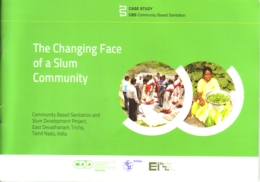
The Changing Face of a Slum Community: Community Based Sanitation and Slum Development Project, East Devadhanam, Trichy, Tamil Nadu, India
Joe DíSouza, dkk
Th.
2.307
The movement of people into densely populated areas due to increasing urbanisation has resulted in increased risk to public health and hygine. Slums in urban areas are often defined as having lack of access to safe drinking water and poor sanitation systems with almost no household hygiene. Access to good sanitation facilities is a cause for concern, especially for those living in slums. Shrinking urban spaces make defecation difficukt and unhygienic. Most slum dwellers usually live without proper toilet facilities and it is women who suffer the most, as privacy is hard to come by during daylight hours.
East Devadhanam is also one such slum, located in a fringe area of Trichy in Tamil Nadu, which emerged as a result of migration and displacement of people from neighbouring areas. One of the largest challenges to public health in this slum was access to safe drinking water. The lack of toilets led to open defecation, cultivating diseases caused due to parasitic and bacterial infections. The sanitation situation in East Devadhanam was deplorable calling for an appropriate sanitation solution in order to improve the health and hygiene conditions of the inhabitans.
With this objective, the Community Based Sanitation and Slum Development (CBSSD) project was implemented by Exnora International, Chennai, with support from the German Federal Ministry for Economic Cooperation and Development (BMZ) and Bremen Overseas Research and Development Association (BORDA). The technical assistance in the project, especially in setting up of DEWATS (Decentralized Wastewater Treatment Systems) was extended by FEDINA DEWATS Coordination Office-FDCO, now Consortium for DEWATS Dissemination (CDD) Society, Bangalore. The Community played a vital role in the entire implementation process of the project. The poor sanitation situation and unhygienic environmental conditions were addressed initially through awareness building and information dissemination. The CBSSD project and DEWATS were foreseen as appropriate interventions towards holistically improving the health and hygiene status of the residents of East Devadhanam.
This publication highlights the process of implementing the CBSSD project in East Devadhanam and records the experiences generated during the course of action. This document bares the constraints faced, lesson learnt and accomplishments in the implementation of the project which could help other organisations and institutions involved in the up-scaling of such approaches and technologies.

Studi Kasus: Sanitasi Berbasis Masyarakat di Kota Batu, Jawa Timur
2008
2.281
Tiga puluh rumah di Kelurahann Temas, Kota Batu, Jawa Timur memiliki usaha pemotongan ayam dan pembuatan tahu dan tempe berskala rumah tangga. Tanpa melalui proses apapun, limbah padat dan cair dari industri rumahan ini langsung dibuang ke saluran-saluran air yang mengalir ke Kali Tulus. Para petani di wilayah bawah, memanfaatkan air dari kali untuk irigasi dan kegiatan sehari-hari lainnya. Akibatnya, banyak penduduk yang menderita gatal-gatal karena memakai air yang terkena polusi tersebut.
Selama dua tahun terakhir, ESP bekerjasama dengan masyarakat dan pemerintah setempat membangun tangki septik komunal di RW XI. Sistem tangki septik komunal dipilih karena kontur wilayah Temas yang berbukit memiliki tingkat kemiringan yang cukup dan memungkinkan untuk sistem perpipaan tanpa pompa.
Untuk mengolah limbah dari industri rumahan, dibuat fasilitas pengolahan limbah (waste water treatment system) yang memanfaatkan sejumlah jenis tanaman dengan sistem berundak untuk menyerap dan menyaring unsur polutan dalam air limbah sebelum limbah dibuang ke sungai. Dan warga Kelurahan Temas kini memiliki sistem pembuangan limbah yang mereka rawat dan kelola sendiri.
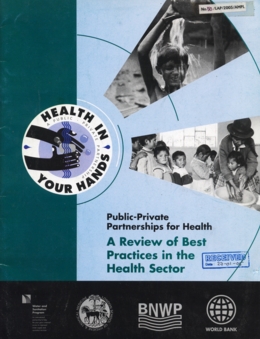
Public-Private Partnerships for Health: A Review of Best Practices in the Health Sector
Ann Thomas, Dr. Valerie Curtis
Th.
1.808
Public-Private Partnerships (PPPs) have evolved as a result of pressure to ensure quality in providing public services. PPPs pool public and private resources, and capitalize on the skills of the respective sectors to improve the delivery of services. Today, PPPs in the health sector focus on preventing diseases suac as sexually transmitted infections and malaria, developing and facilitating access to vaccines and drugs, and improving health service delivery. Whether international or national in scope, PPPs challenge the traditional distinction between the public and private sector, and their perceived aims and responsibilities.
Although a number of PPPs have benn established in the public health sector over the past few decades, little information is available on the necessary conditions leading to their formation. To address this need, this review has been prepared as a guide to best practices for PPPs in the health sector. It examines the underlying philosophy of PPPs, their costs, benefits, and impacts, as well as their governance, management, and implementation strategies.
The report draws on the experiences of six case studies of PPP initiatives, interviews with key players from the private and public sectors, and literature. The review offers general lessons of principle and process for forming partnerships and effectively managing them.
Contents:
Introduction
Are Public-Private Partnerships the new panacea
What are Public-Private Partnerships
The evolution of Public-Private Partnerships
Why join a Public-Private Partnerships
Philosophy and basic strategy
Lessons learned
Annex 1. Case Studies
I. Public-Private Partnerships to promote handwashing with soap in Central America
II. NetMark: Partnership to increase the use of insecticide-treated materials to prevent malaria
III. Partnership with condom manufactures to promote condom use in red light areas in Indonesia
IV. Partnership to increase the consumption of iodized salt in Pakistan
V. PHASE: Clean Hands, happy hands, hygiene promotion in schools
VI. The global alliance for Vaccines and Immunization
References

Poverty and Sanitation: An analysis of the linkage between poverty and access to basic sanitation in Honduras
Beatriz Schippner & Lylliam Moya (Ed)
Th.
1.610
This document presents an analysis of poverty levels among rural and urban households of Honduras and their access to sanitation solutions. It identifies key aspects for improving services and contributing to sector policies, strategies and investments plans that atrget the poor. The analysis is based on a broad review of available documentation and data.
This study shows that the low income population in Honduras is mainly rural (74 %) and that the rest resides in urban areas (26 %). The highest levels of access to sanitation services in cities corresponds to household connections to piped sewerage networks, but this option mainly serves the non-poor. Only 31 % of teh moderately poor and 12 % in extreme poverty in urban areas have achieved access to sewerage networks. In rural areas sanitation solutions are generally on site excreta disposal (septic tanks or latrines) but only 70 % of the moderately poor and 49 % of those in extreme poverty have access to even these solutions.
This study identifies three scenarios for sanitation access; urban areas, concentrated rural communities, and dispersed rural villages.
Contents:
Presentation
Executive Summary
1. Inroduction
2. Access to sanitation and the situation at the national level
3. Rural sanitation
4. Urban sanitation
5. Considerations for an urban sanitation strategy
6. Considerations for a rural sanitation strategy
7. Investment, financing and subsidies for sanitation
8. Monitoring and institutional support for sustainable sanitation services
9. Conclusions and recommendations
Bibliography
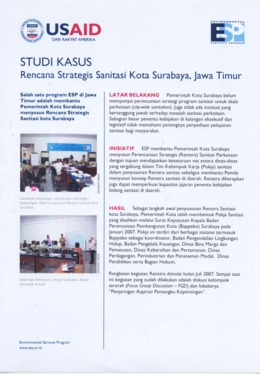
Studi Kasus Rencana Strategis Sanitasi Kota Surabaya, Jawa Timur
30 Maret 2009
2.045
Studi Kasus Rencana Strategis Sanitasi Kota Surabaya, Jawa Timur merupakan salah satu program ESP di Jawa Timur yang membantu Pemerintah Kota Surabaya menyusun Rencana Strategis Sanitasi Kota Surabaya.

Studi Kasus Sistem Sanitasi Komunal di Kabupaten Aceh Besar, NAD
30 Maret 2009
1.815
Studi Kasus Sistem Sanitasi komunal di Kabupaten Aceh Besar, Nanggroe Aceh Darussalam merupakan program ESP dalam membangun proyek pilot siste pembuangan air limbah ramah lingkungan di Aceh.
